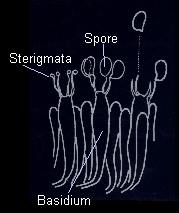Subdivision: Basidiomycotina
 Basidiomycetes are characterised primarily by the sexual spores (basidiospores) being produced on a cell called a basidium, usually in fours. Many but not all have septal structures called a clamp connection during most of the life cycle. No other group of fungi has these.
Basidiomycetes are characterised primarily by the sexual spores (basidiospores) being produced on a cell called a basidium, usually in fours. Many but not all have septal structures called a clamp connection during most of the life cycle. No other group of fungi has these. Basidiomycete have many features in common with the Ascomycetes; mycelia with chitinous cell walls that are regularly septate, cell division often accomplished by clamp formation, and the presence of an extended dikaryon stage. This means that the two nuclei brought together in mating do not fuse in the thallus of the fungus, but instead exist side-by-side in each cell.
Basidiomycete have many features in common with the Ascomycetes; mycelia with chitinous cell walls that are regularly septate, cell division often accomplished by clamp formation, and the presence of an extended dikaryon stage. This means that the two nuclei brought together in mating do not fuse in the thallus of the fungus, but instead exist side-by-side in each cell. Order: BoletalesFamily: Agaricaceae
Family: Bolbitiaceae
Family: Clavariaceae
Family: Coprinaceae
Family: Cortinariaceae
Family: Crepidotaceae
Family: Entolomataceae
Family: Hydnangiaceae
Family: Marasmiaceae
Family: Pleurotaceae
Family: Pluteaceae
Family: Schizophyllaceae
Family: Strophariaceae
Family: Tricholomataceae
Family: Tubariaceae
Order: CantharellalesFamily: Boletaceae
Family: Boletinellaceae
Family: Calostomataceae
Family: Suillaceae
Family: Paxillaceae
Family: Rhizopogonaceae
Family: Sclerodermataceae
Family: CantharellaceaeOrder: Dacrymycetale
Family: Clavulinaceae
Family: Hydnaceae
Family: DacrymyceaceaeOrder: Gomphales
Order: HymenochaetalesFamily: Gomphaceae
Family: Hysterangiaceae
Family: Phallaceae
Order: PolyporalesFamily: Hymenochaetaceae
Family: AtheliaceaeOrder: Russulales
Family: Ganodermataceae
Family: Gloeophyllaceae
Family: Hapalopilaceae
Family: Polyporaceae
Family: Steccherinaceae
Family: AuriscalpiaceaeOrder: Thelephorales
Family: Corticiaceae
Family: Hericiaceae
Family: Meruliaceae
Family: Russulaceae
Family: Stereaceae
Subclass: Phragmobasidiomycetida (jelly fungi)Family: Bankeraceae
Family: Thelephoraceae
Order: TremellalesFamily: Auriculariace
Family: Hyaloriaceae
Family: ExidiaceaeClass: Teliomycetes and Urediniomycetes (Rust and Smuts)
Family: Tremellaceae
Family: Tremellodendropsidaceae